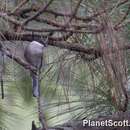zh-TW
在導航的名稱


Hemipus a zo ur genad e rummatadur an evned, krouet e 1844 gant an naturour breizhveuriat Brian Houghton Hodgson (1800 pe 1801-1894).
Daou spesad golvaneged a ya d'ober ar genad :
O c'havout a reer en Azia, pevar (4) isspesad dezhe en holl.
Gwechall e veze renket er c'herentiad Tephrodornithidae a zalc'he ar genadoù Tephrodornis ha Philentoma ivez.
a vo kavet e Wikimedia Commons.
Hemipus a zo ur genad e rummatadur an evned, krouet e 1844 gant an naturour breizhveuriat Brian Houghton Hodgson (1800 pe 1801-1894).
Hemipus és un gènere d'ocells de la família dels tefrodornítids (Tephrodornithidae ).
Segons la Classificació del Congrés Ornitològic Internacional (versió 2.6, 2010) aquest gènere està format per dues espècies:
Hemipus és un gènere d'ocells de la família dels tefrodornítids (Tephrodornithidae ).
The flycatcher-shrikes are two species of small Asian passerine bird belonging to the genus Hemipus. They are now usually placed in the Vangidae.
They are 12.5 to 14.5 cm (4.9 to 5.7 in) in length.[1] They are slender birds with fairly long wings and tails. The bill and feet are black.[2] The plumage is dark above and pale below with white on the rump. The bar-winged flycatcher-shrike has a large white patch on the wing which the black-winged flycatcher-shrike lacks.[1]
They are found in broad-leaved forest, forest edge and secondary forest in southern Asia. Both species have large ranges and are not considered to be threatened. The bar-winged flycatcher-shrike occurs in the Indian Subcontinent, south-west China, mainland South-east Asia and on the islands of Sumatra and Borneo.[1] The black-winged flycatcher-shrike is found in the Malay Peninsula and on Sumatra, Borneo, Java and Bali.[2]
They forage actively in the forest canopy for insects. They are often found in groups and frequently join mixed-species foraging flocks.[2] They will also catch insects in flight.[3]
The nest is cup-shaped and built on a tree branch. Two or three eggs are laid; they are greenish or pinkish with darker markings.[1] Both parents are involved in building the nest, incubating the eggs and rearing the young.[3]
The two shrike-flycatcher species of Africa are also occasionally known as flycatcher-shrikes:
The flycatcher-shrikes are two species of small Asian passerine bird belonging to the genus Hemipus. They are now usually placed in the Vangidae.
Hemipus es un género de aves paseriformes perteneciente a la familia Vangidae.[1] Sus miembros son propios del sur de Asia. Tradicionalmente pertenecierno a la familia Campephagidae, posteriormente fueron clasificados transitoriamente en la familia Tephrodornithidae,[2] pero finalmente han sido trasladados a la familia Vangidae.
Hemipus es un género de aves paseriformes perteneciente a la familia Vangidae. Sus miembros son propios del sur de Asia. Tradicionalmente pertenecierno a la familia Campephagidae, posteriormente fueron clasificados transitoriamente en la familia Tephrodornithidae, pero finalmente han sido trasladados a la familia Vangidae.
Sieppokäpinkäiset (Hemipus) on vangojen heimoon kuuluva varpuslintusuku. Aiemmin suku luettiin kuuluvaksi käpinkäisiin. Sieppokäpinkäisten sukuun kuuluu BirdLifen mukaan kaksi lajia[1].
Sieppokäpinkäiset (Hemipus) on vangojen heimoon kuuluva varpuslintusuku. Aiemmin suku luettiin kuuluvaksi käpinkäisiin. Sieppokäpinkäisten sukuun kuuluu BirdLifen mukaan kaksi lajia.
Hemipus est un genre de passereaux de la famille des Vangidae. Il regroupe deux espèces d'échenilleurs.
Ce genre se trouve à l'état naturel en Asie du Sud[2], du Sud-Est[2],[3] et dans le Sud de la Chine[2].
D'après la classification de référence du Congrès ornithologique international (version 8.2, 2018)[1] :
Ce genre appartenait auparavant à l'ancienne famille des Tephrodornithidae. En 2018, le congrès ornithologique international a décidé de le rattacher à la famille des Vangidae et de supprimer la famille des Tephrodornithidae[1].
Hemipus est un genre de passereaux de la famille des Vangidae. Il regroupe deux espèces d'échenilleurs.
Hemipus Hodgson, 1844 è un genere di uccelli della famiglia Vangidae.[1]
Il genere è diffuso nel subcontinente indiano, nel sud-est asiatico e nel sud della Cina.[2][3]
Il genere Hemipus veniva in passato inquadrato tra i Campefagidi. Studi di sequenziamento del DNA hanno rivelato affinità con il genere Tephrodornis (ex Campephagidae) e con il genere Philentoma (ex Monarchidae); i tre generi, temporaneamente segregati nella famiglia Tephrodornitidae Moyle et al., 2006, sono stati recentemente inclusi nella famiglia Vangidae.[4]
Comprende le seguenti specie:[1]
Hemipus is een geslacht van zangvogels uit de familie Vangidae.
Dit geslacht behoorde vroeger tot de familie van de rupsvogels (Campephagidae). Moleculair genetisch onderzoek wees uit dat Hemipus in deze familie niet thuishoorde.[1] Het geslacht is sinds 2018 ingedeeld bij de Vangidae.[2]
Hemipus is een geslacht van zangvogels uit de familie Vangidae.
Hemipus – rodzaj ptaka z rodziny wangowatych (Vangidae).
Rodzaj obejmuje gatunki występujące w Azji Południowo-Wschodniej[3].
Długość ciała 14-15 cm, masa ciała 8,5-14 g[4].
Nazwa rodzajowa pochodzi od greckiego słowa ἡμιπους hēmipous, ἡμιποδος hēmipodos – „półstopa, mała stopa” (ἡμι- hēmi- – „mały” (ἡμισυς hēmisus – „pół”)) oraz πους pous, ποδος podos – „stopa”[5].
Hemipus picaecolor Hodgson = Muscicapa picata Sykes
Do rodzaju należą następujące gatunki[3][6]:
Hemipus – rodzaj ptaka z rodziny wangowatych (Vangidae).
Hemipus är ett släkte i familjen vangor inom ordningen tättingar.[1]
Hemipus omfattar endast fyra arter som förekommer från Himalaya till Bali:[1] [2]
Släktet har länge flyttats runt mellan olika familjer. Fram tills nyligen placerades arterna istället i familjen skogstörnskator (Tephrodornithidae) med filentomor och släktet Tephrodornis. Studier visar dock att denna grupp är nära släkt med vangorna och flyttas nu allmänt dit.
Hemipus är ett släkte i familjen vangor inom ordningen tättingar.
Hemipus omfattar endast fyra arter som förekommer från Himalaya till Bali:
Bandvingad skogstörnskata (H picatus) Svartvingad skogstörnskata (H hirundinaceus)Hemipus là một chi chim theo truyền thống xếp trong họ Campephagidae.[1] Tuy nhiên, một số phân tích gần đây cho thấy nó có quan hệ họ hàng gần với Tephrodornis[2] và cả hai chi này gần đây được xếp trong họ Vangidae[3].
Hemipus là một chi chim theo truyền thống xếp trong họ Campephagidae. Tuy nhiên, một số phân tích gần đây cho thấy nó có quan hệ họ hàng gần với Tephrodornis và cả hai chi này gần đây được xếp trong họ Vangidae.
鹟鵙是鹟鵙属(学名:Hemipus)下的两种小型亚洲雀形目鸟类。传统上,该属被归入山椒鸟科(Campephagidae)下。但目前有迹象表明,与钩嘴林鵙属(Tephrodornis)和王鵙属(Philentoma)一样,该属与盔鵙科(Prionopidae)及钩嘴鵙科(Vangidae)有着更近的亲缘关系。[1]
鹟鵙长约12.5至14.5厘米,[2]体型纤细,两翼和尾部相当长。喙部和双足为黑色。[3]上身羽毛较深,下身较浅,臀部白色。褐背鹟鵙的两翼上有大块白色斑点,而黑翅鹟鵙没有。[2]
鹟鵙分布在南亚的阔叶林、林缘和次生林中。两个物种都有着大范围的分布而不被视为受威胁物种。褐背鹟鵙分布于印度次大陆、中国西南、东南亚大陆以及苏门答腊和婆罗洲的岛屿上。[2]黑翅鹟鵙分布于马来半岛、苏门答腊、婆罗洲、爪哇岛和巴厘岛。[3]
鹟鵙常在林冠上觅食昆虫。常被成群地发现,常参与多种合群觅食(英语:mixed-species foraging flock)。[3]鹟鵙在飞翔时亦能捕获昆虫。[4]
巢为杯状,建于树干上。每次可产二至三枚鸟蛋,色泽浅绿或浅粉,并带有较深的斑纹。[2]双亲均会参与鸟巢的搭建、鸟蛋的孵化和幼鸟的抚养。[4]
以下两种非洲的鵙鹟有时也会被认为是鹟鵙: